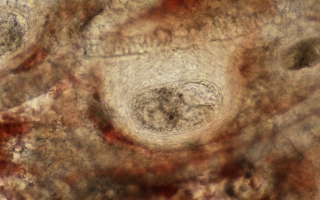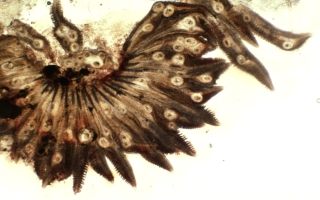
 Digenetic Trematodes
Digenetic Trematodes

 Digenetic Trematodes
Digenetic Trematodes
The digenetic trematodes are a group of parasitic flatworms that require two or more hosts for completion of the life cycle. The typical digenetic trematode has three hosts including an aquatic snail, a fish (e.g. tilapia) and a fish eating, fish, bird or mammal. The stage of the parasite is the metacercaria which would occur in a fish like tilapia. The metacercarial stage is encysted in the tissues of the fish which means it remains in one location, does not (in that stage) reproduce and usually causes little damage to the fish host unless it is localized in a critical organ (e.g. the eye) and /or there are large numbers of the parasite present.
Digenetic trematode infections in tilapia are unusual and in our experience limited to fish raised in freshwater environments. Possibly, tilapia are not a particularly good 2nd intermediate host for the species of digenetic trematode that occurs in freshwater ecosystems in the Islands.
When found, the metacercaria will be encysted in the filaments of the gills and visible microscopically. The metacercaria appear as a well circumscribed, grape like body with an outer shell (wall) surrounding a young adult worm. The flatworm has several rows of spikes at the front end of the body which are often visible and these worms will slowly move (roll) around within the cyst. This trematode conforms to the descriptions for Centrocestus formosanus and apparently carps and Chinese catfish are the natural 2nd intermediate hosts. The night heron, Nycticorax nycticorax, is the likely natural definitive host for this parasite.
These parasites appear as somewhat spherical structures with a distinct outer capsule wall around a often slowly moving internal organism. Under 400X magnification, a row of spikes can often be observed that surround the mouth region of the parasite.
There are no chemical control options that we could recommend for control of metacercarial infections in cultured tilapia. Clearly however, fish should not be cultured in ponds which are infested with the common freshwater spiral snails Stenomelania newcombi or Thiara granifera. These snails are the 1st intermediate host for the several digenetic trematodes in Hawaii that use freshwater fish as the 2nd intermediate host. Fish cultured with these snails invariably are infected by one or more of the flukes and this situation should be avoided.
| file: /Techref/other/pond/tilapia/digenetic_trematodes.htm, 3KB, , updated: 2014/12/11 11:31, local time: 2025/10/19 09:53,
216.73.216.56,10-1-100-33:LOG IN
|
| ©2025 These pages are served without commercial sponsorship. (No popup ads, etc...).Bandwidth abuse increases hosting cost forcing sponsorship or shutdown. This server aggressively defends against automated copying for any reason including offline viewing, duplication, etc... Please respect this requirement and DO NOT RIP THIS SITE. Questions? <A HREF="http://massmind.ecomorder.com/Techref/other/pond/tilapia/digenetic_trematodes.htm"> Tilapia Topic: Disease Vectors</A> |
| Did you find what you needed? |
Welcome to ecomorder.com! |
|
The Backwoods Guide to Computer Lingo |
.